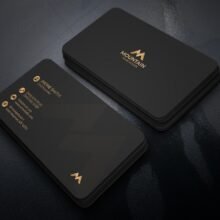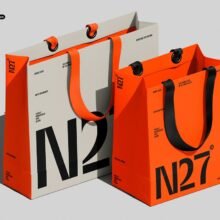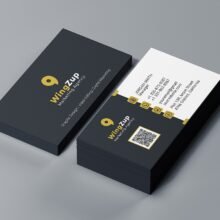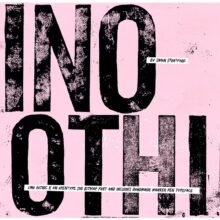The Corporate Business Card: A Pillar of Professional Identity and Brand Communication
In the fast-paced, technology-driven world of modern business, where emails, LinkedIn profiles, and digital signatures dominate communication, the corporate business card continues to hold a strong, irreplaceable position in professional culture. More than just a piece of printed paper, the corporate business card is a strategic branding tool, a first impression in miniature, and a symbol of professionalism.
Whether exchanged at boardroom meetings, networking events, international conferences, or casual introductions, the business card remains one of the most personal, portable, and powerful forms of communication in the corporate landscape.
What Is a Corporate Business Card?
A Corporate Business Card is an official card issued by a company to its employees, especially those in executive, client-facing, or managerial roles. It serves as a professional identification and branding item that shares essential contact details, communicates the individual’s role within the organization, and reflects the company’s image and ethos.
Unlike casual or creative Corporate Business Card, corporate cards follow stricter guidelines regarding branding, design, hierarchy of information, color schemes, and professionalism.

Why the Corporate Business Card Still Matters
Despite the rise of digital connectivity, corporate business cards continue to be essential for various reasons:
1. Credibility and Legitimacy
Presenting a well-designed Corporate Business Card immediately establishes credibility. It signals that you are affiliated with a legitimate organization and hold an authorized position, creating a sense of trust in the person you’re speaking with.
2. First Impressions Matter
Studies show that people form opinions within seconds of a first interaction. A clean, high-quality Corporate Business Card can leave a strong impression and make the person you’re meeting more likely to remember and respect you.
3. Professional Etiquette
Corporate Business Card in many business cultures, especially in countries like Japan, South Korea, China, and parts of Europe, exchanging business cards is a deeply rooted tradition. Not having a card can be seen as unprepared or even disrespectful in formal business settings.
4. Brand Representation
A Corporate Business Card is an extension of your company’s brand. From the logo to the color palette, it encapsulates your organization’s personality, values, and tone — whether conservative and traditional or modern and tech-driven.
5. Tangible and Memorable
Unlike digital connections, which can be lost in the noise of crowded inboxes, a physical card is tactile and visually engaging. It’s something recipients can hold, store, and revisit, often leading to better memory recall.
Key Elements of a Corporate Business Card
A standard corporate business card includes essential and standardized components that balance branding and personal information:
1. Company Logo
The company logo should be prominent, usually at the top left or center, to reinforce brand identity.
2. Employee’s Full Name
The name should be displayed clearly and often slightly larger than the rest of the text to establish personal identity.
3. Job Title and Department
Clarifies the individual’s role and authority level. Titles should be accurate, consistent, and align with the company’s internal structure.
4. Company Contact Details
This includes the corporate address, general email, and office telephone number.
5. Personal Contact Information
Depending on the organization’s policy, this might include the direct office line, mobile number, or corporate email address.
6. Company Website
Helps direct the cardholder to your company’s online presence for further engagement.
7. Social Media Handles (Optional)
LinkedIn is the most common platform to include, but only if it aligns with the company’s branding strategy.

Corporate Business Card Design Guidelines
Consistency, professionalism, and clarity are paramount in corporate business card design. Here’s what sets successful designs apart:
1. Brand Cohesion
The card must align with the company’s official brand guidelines — this includes logo usage, font styles, color schemes, and spacing. Every card should look like it belongs to the same family, regardless of who it is issued to.
2. Professional Typography
Fonts should be legible and formal. Sans-serif fonts like Helvetica, Lato, or Arial are popular for modern corporate designs, while serif fonts like Times New Roman or Garamond are used for traditional and legal firms.
3. Color Palette
Corporate business cards typically use company-approved colors — blues, grays, whites, or blacks — to signal trust, stability, and reliability.
4. Print Quality
Investing in high-quality paper stock and finishes like matte, soft-touch, or UV spot gloss enhances the tactile experience and reflects positively on the company’s attention to detail.
5. Minimalism with Intent
Less is more. Overcrowding the card with information, colors, or images reduces clarity. Stick to the essentials with balanced spacing for visual comfort.
More Read : Click Here
Variations in Corporate Business Cards by Industry
Different industries tailor their business card designs to reflect industry norms:
-
Finance & Law: Traditional, conservative layouts with minimalistic, dark color palettes.
-
Tech & Startups: Clean, modern designs with bold fonts and integrated tech features like QR codes or NFC.
-
Healthcare: Simple, clean designs with medical-specific titles and credentials.
-
Real Estate: Often includes a headshot, agent license number, and vibrant branding to attract attention.
Enhancing Your Corporate Business Card for 2025 and Beyond
In today’s global and digital business environment, a few additional design features can elevate your card:
1. QR Codes
Add a scannable QR code that links to your company’s portfolio, your LinkedIn page, or a corporate video introduction.
2. Dual Language Versions
If working in international markets, especially Asia or Europe, having one side in English and another in the local language can boost accessibility and cultural respect.
3. NFC Business Cards
Many companies are now integrating Near-Field Communication (NFC) chips in their business cards, enabling recipients to tap the card on their phone to receive your contact details digitally.
4. Digital Twin
Create a digital business card version for use in email signatures or Zoom backgrounds. This allows consistency in branding across all physical and digital touchpoints.
Common Mistakes to Avoid
Even large corporations can make costly errors in business card design and usage. Avoid the following:
-
Outdated Information: Always double-check names, titles, and contact details before printing.
-
Overly Flashy Designs: Corporate cards are meant to convey trust and professionalism — avoid glitter, overuse of colors, or gimmicky shapes unless industry-appropriate.
-
Low-Quality Printing: Poor print quality can reflect poorly on your company’s brand, signaling carelessness or budget constraints.
-
Inconsistent Layouts: All employee cards should follow a uniform template. Personalization should never override brand consistency.

Conclusion: The Corporate Business Card as a Strategic Asset
The corporate business card is far more than a formality — it’s a strategic business asset that bridges the gap between brand identity and personal professionalism. In every exchange, it tells a story about your company’s standards, attention to detail, and how much it values human connection.
In an increasingly digital world, the tangible nature of a business card — especially one that is well-designed, informative, and professionally presented — continues to play a critical role in shaping relationships and opening doors.
Whether you’re a multinational executive, a B2B sales representative, or an HR professional attending a career fair, the corporate business card should always be sharp, simple, and powerful — just like your brand.

















